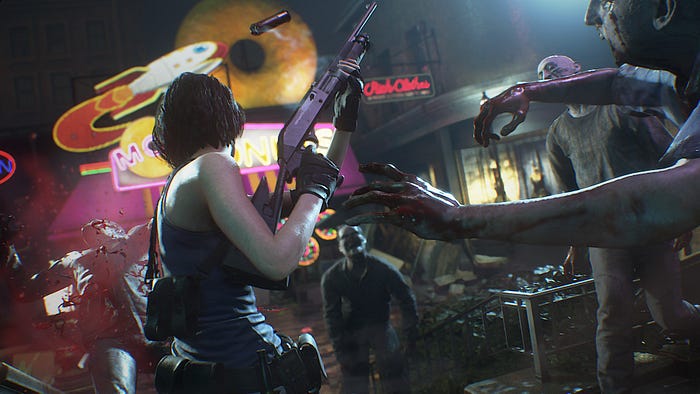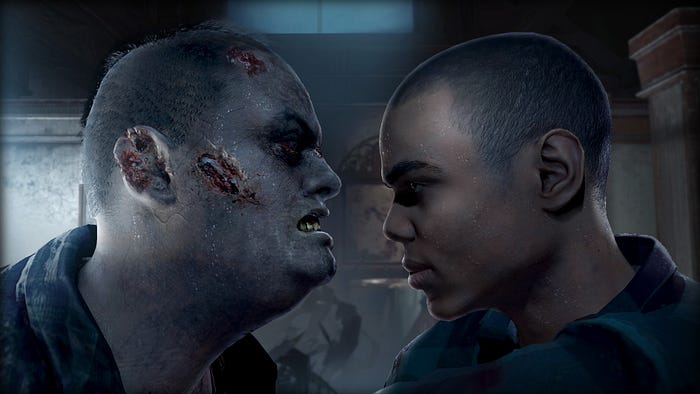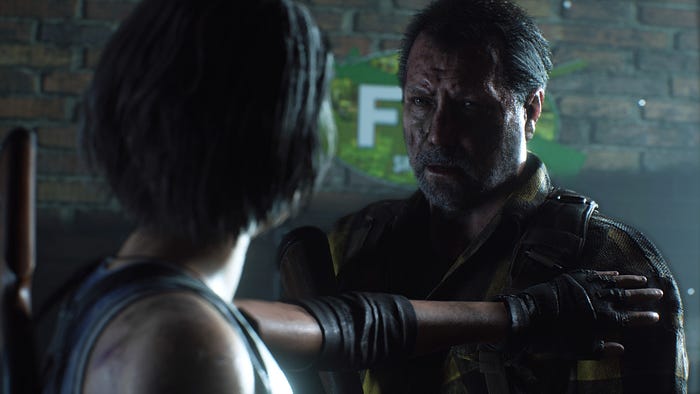Resident Evil 3 Review
Surviving the final pandemic

Review code provided by Capcom for the PlayStation 4.
Capcom have unwittingly produced the most prescient game of 2020. Resident Evil 3 is not merely a game bursting at the seams with bombastic action, set piece battles, and an endless sea of ravenous undead. Oh, don’t worry; all of those ingredients are here, and they’re delivered with greater confidence, expertise, and technical proficiency than I’ve ever seen before. But there’s another side to Resident Evil 3. It’s the surprisingly intimate exploration of a city’s final dying breaths; from the individual nightmares of its helpless denizens as their neighbourhoods are consumed by a terrifying pandemic, to the abundant evidence of a city’s valiant attempts to mitigate the crisis as it drowns in suffering.
There’s a lot of ground to cover here, so let’s start right at the beginning.
What is Resident Evil?
It might be more appropriate to ask: What is Resident Evil to you? As a franchise, Resident Evil is something of a chameleon, given its numerous manifestations over the years. Broadly speaking, the Resident Evil games tend to be separated into discrete groupings. Purists tend to speak fondly of the first two games as being quintessential survival horror experiences. Sure, there were bouts of action, but these titles were largely defined by a permanent state of quiet unease punctuated by the occasional jump-scare. Capcom violently smashed their own archetype in 2005’s Resident Evil 4, which felt like the video game equivalent of 28 Days Later; atmospheric tension was replaced with sheer, all-encompassing panic. Enemies moved fast, they surrounded the player, and they could intelligently work together to hunt you down (going so far as to erect ladders against buildings, should you mistakenly believe that perching upon a rooftop would confer any kind of safety). Subsequent games largely elaborated upon this formula in one way or another until the release of Resident Evil 7 in 2017. Capcom returned to the drawing board yet again, delivering an utterly terrifying first-person experience set in the now-iconic Baker household (a charming little plantation house-of-horror nestled in a lonely corner of Louisiana). More recently — and much to my delight — Capcom produced a stunning remake of Resident Evil 2.

Why all this throat clearing? For one thing, Resident Evil means different things to different people. Your personal preferences around the game may vary depending, at least in part, on your entry point to the series. For what it’s worth, I started right at the beginning, but I definitely appreciate the various “flavours” of Resident Evil. My fleeting look back at the series to date is also notable due to a key omission. Resident Evil 3: Nemesis, released for the PlayStation in 1999, is often considered something of a black sheep in the franchise. It was originally intended to be a spin-off, actually; in some respects, this isn’t highly surprising, given its relatively short length and unusual premise, at least compared to its predecessors.
There are several key elements that defined Resident Evil 3: Nemesis. Most obvious, of course, is the titular villain himself. Nemesis was something of a Mr. X on steroids; and unlike Mr. X (who patrolled the Raccoon City Police Station in search of the player), Nemesis aggressively targeted and pursued players through a tangled web of city streets. These pursuits occasionally forced players into strange choose your own adventure decision points (do I run into the police station or fight the creature? 🤔), which provided a degree of variation in terms of how the plot articulated. To this day, Resident Evil 3: Nemesis remains a controversial entry in the franchise. It still has plenty of detractors, although I personally have very fond memories of the original game.
If you are familiar with last year’s remake of Resident Evil 2, then you’ll know that Capcom did two key things very successfully on that occasion: first, they respected the DNA of the original version, leaning into and enhancing the elements that made it great. And second, they weren’t afraid to boldly delve into new territory — adding new spaces, rewriting the plot and dialogue, dramatically enhancing movement and combat, and wielding player nostalgia as a weapon of shock-and-awe for returning series veterans.
The big question is: has Capcom managed to scale the same dizzying heights with their remake of Resident Evil 3? Let’s find out.

Waking nightmare
Jill Valentine, a former member of the Raccoon City Police Department, is plagued by nightmares. “Gets worse every night,” she murmurs to herself after a particularly vivid lucid dream. Rain patters across her apartment windows, pierced by the urgent cry of sirens frantically rushing from place to place. Red-and-blue lights flood the apartment, casting angry shadows across its walls. Resident Evil 3 initially grants us a precious moment of quiet to become Jill; I found myself spending a great deal of time exploring her wonderfully-detailed living space. Every single object in her apartment is meaningful in some way, acting as pieces of a broader mosaic that assemble her character through careful and attentive environmental storytelling. It appears that Jill and all of her neighbours are living under home quarantine, monitored by Umbrella, the malevolent corporation that caused the deadly outbreak.
Resident Evil 3 grants you just enough time to become acquainted with Jill and her living situation before it violently, carelessly throws you into the utter chaos that Raccoon City has become. You will very quickly find yourself running for your life from an overwhelmingly powerful, seemingly-invincible nemesis (😎) who apparently won’t rest until it has obliterated you. In addition to avoiding Nemesis, you have one simple goal: escape Raccoon City.
I remember the original game kicking off in chaotic fashion. From memory, though, your cat-and-mouse game with Nemesis didn’t begin so early in the adventure. Not only does Nemesis seek you out much earlier this time, but your first several encounters with him will leave you utterly breathless. Each one is its own action-movie set piece that typically involve the narrowest of escapes. There’s a lot to say about Nemesis specifically, given that he’s such a major part of the game. However, I’d be doing the experience real injustice if I focus solely on him. Resident Evil 3 has so much to offer well beyond its infamous villain, so let’s return to him a little later.

Dying city
You haven’t seen Raccoon City until now. Not really. Remember how the shockingly-impressive RE Engine, combined with Capcom’s masterful art team, re-created the Raccoon City Police Station in Resident Evil 2? Imagine that same extraordinary combination applied to the entire city. Resident Evil 3’s Raccoon City is crafted with unbelievable imagination and fidelity. Eerily quiet, foreboding alleyways shrouded in deep shadows give way to wide boulevards illuminated by an ominous combination of neon signs and burning vehicles. It’s breathtaking.
While not exactly an open-world experience, Resident Evil 3 does feel quite a lot more expansive than Resident Evil 2. As you progress through the story, you will find yourself exploring different locales well beyond the streets where the adventure begins. Several of these areas — particularly the outdoor ones — are relatively open and non-linear. You’ll spend a good chunk of the early game in the Raccoon City downtown and subway. As you explore, you will notice that numerous buildings can be entered (a couple even have multiple entrances, meaning you’ll be running back-and-forth through them as you complete tasks); moving between different streets and buildings is entirely seamless, with no loading screens in sight.
Just as with Jill’s apartment, I found myself constantly stopping to take in the impressive detail around the city. You’ll occasionally wander past crashed police cars where you’ll hear the radio pointlessly chattering away, for example. You will see evidence everywhere of a city desperately trying to keep up with a rolling human extinction event — first, the pandemic itself and then the frantic struggle to barricade buildings to stop hoards of murderous undead from overwhelming the population.

Shooting gallery
Although you will have plenty of moments to take in the sights and sounds of the city, I don’t want to give you the impression that this is some kind of Raccoon City walking simulator. Resident Evil 3 is quite literally overflowing with enemies at almost every turn. Zombies, of course, are the series staple and they’re well and truly accounted for here. In this version, Capcom introduces at least two major new zombie varieties, as well as a couple of other devilishly nasty opponents.
The radical increase in enemies is countered by a substantial boost to your own arsenal. You will still need to manage and inventory and a limited supply of ammunition, but make no mistake: Resident Evil 3 is quite comfortable to welcome the trigger-happy folk among us. Combat is both more frequent and necessary than in Resident Evil 2, and thankfully, it is handled superbly here.
It all starts with character movement. This was the aspect of the game that most pleasantly surprised me. Jill moves incredibly fluidly in all directions, and this time around, she possesses a kind of “quick dash” move that enables you to dodge enemies at the last minute (if you’ve performed a successful dodge, the screen will flash and you’ll hear a confirmatory sound). Don’t worry if this sounds like it makes combat trivial, because it really doesn’t. This time around you’ll often find yourself surrounded by zombies. It’s not uncommon to be firing at one enemy in front of you, only to be ambushed from the back or the side when you least expect it. Sometimes you will open a door and half a dozen zombies will flood out, almost tripping over themselves to get at your jugular.
The fluid movement feels great, but it is coupled with superb weapon mechanics. As with other Resident Evil titles, you’ll acquire numerous weapons throughout the game — and you will have some limited opportunities to upgrade them. Thankfully, they all feel fantastic to use, especially the precision-based weapons. This is because the zombies in Resident Evil 3 not only take location-based damage, but they react realistically to gunshots (this doesn’t just include flinching and stumbling; layers of flesh will literally tear away from their bodies as your bullets piece through them). Right up to the end of the game, I never once got tired of shooting zombies, so good is the combat model here.

Survival instinct
Given everything I’ve said so far, you won’t find it surprising when I say that Resident Evil 3 leans into combat in a way that prioritises it above other concerns. The survival aspect of survival horror, in this case, is more about body count than careful resources management. As I said earlier, you do still have an inventory and that inventory is definitely finite. This does mean you won’t be able to fill it with endless weaponry, healing items, and utility/story items. So, it’s still true that you will need to consider when to save your game and what items to carry on you as you explore. But Resident Evil 3 feels like it’s quite a bit more generous with both ammunition and inventory space (you’ll unlock multiple inventory upgrades as you play and as you get closer to the end of the game, you’ll be spending very little time worrying about how much you can carry). I don’t think for a second that any of this is accidental, or the result of sloppy balancing — clearly, Resident Evil 3 wants you to feel more comfortable actively taking on enemy encounters rather than avoiding them. In various ways, the game guides players in this direction.
This is where your history and preferences with the franchise come into play. If you really prefer that slower-paced atmospheric tension where every single bullet counts, then Resident Evil 3 really…isn’t that. On the other hand, this game (thankfully) doesn’t try to amp up the action while still leaving the player encumbered with awful, sluggish controls and unsatisfying combat. In other words, Resident Evil 3 knows what it wants to be, and it achieves this exceptionally well.
There’s another casualty here, though: puzzles. Resident Evil games are famous (or infamous?) for their puzzles. And although there are some puzzles here, they’re pretty thin on the ground. Many of the environmental challenges in Resident Evil 3 are less about weird, obtuse puzzles and more about logical ways of opening up new traversal options. For example, when you return to the police station, you’ll need a police officer’s ID card to access various rooms — with only a couple of exceptions, this card allows you to pretty much access everything in the building. In other words, you won’t find a giant list of different oddly-shaped keys and you won’t be asked to insert jewels into statues’ eyes or anything like that. It’s a far more streamlined experience.
Rather than rely on those tropes, Resident Evil 3 leverages the idea of multiple characters exploring the same locations a vehicle for simple puzzle solving. Throughout Resident Evil 3, you’ll play as either Jill or Carlos (this is also true in the original game, although it’s handled radically differently in the remake). Both of these characters have their own special move (Jill can do the “dodge” and Carlos can shove enemies backwards if they get too close), but they also have their own inventories and items. As just one example, Jill has the bolt cutters, which you’ll occasionally need to cut chains that bar entry to different places in the city. Sometimes Jill and Carlos will explore entirely different areas of the city, and at other times, the two will dovetail across the same locale during different time periods. This can make “backtracking” in the same location more interesting. While playing as Carlos, for example, you might come across several areas that can’t be accessed or opened until you return later as Jill.
It’s worth noting, too, that the outstanding map from Resident Evil 2 returns here in all its glory. You’ll be able to see which locations you’re still exploring, which have been “completed”, and the game will mark important items or points of interest on the map as you discover them. I found this to be even more useful given the larger scale of this game’s locales.

Fear factor
I’ve talked about the survival component of survival horror. But what about the horror part? As I was playing Resident Evil 3, I was actively thinking about how this game deals with horror especially compared to Resident Evil 2. One major reason that this theme occupied so much mental real estate is because this is the first Resident Evil game I played on my own. Although I love this series, I’m a total wuss when it comes to horror games. And traditionally, I’ve always played the series with my siblings. Well, thanks to COVID-19 and self-isolation at home, that just wasn’t going to happen this time. So as you can imagine, I approached Resident Evil 3 with a little more trepidation than usual.
It must be said that I didn’t find Resident Evil 3 to be terribly scary. Right off the bat, I don’t think it came close to Resident Evil 2 in terms of its impact on me and my sense of fear. There are some obvious reasons for this, in retrospect. The most salient of which is the aforementioned emphasis on combat. Because I was pretty regularly armed to the teeth, I rarely felt under substantial threat from enemies (with only a couple of serious exceptions). I found myself actively seeking out combat encounters because they were so much fun. And although there are a few jump scares here and there (including an absolutely fantastic encounter with one enemy in particular…), I generally felt that Resident Evil 2 made me feel more…afraid.
Having said that, I also recognise that Resident Evil 3 is perhaps going for a different type of fear. You won’t find yourself fearfully peeking around every corner as you might have done in Resident Evil 2. Instead, you’ll more regularly find yourself running. Where its predecessor amped up atmospheric dread, Resident Evil 3 can devolve into pure panic.
That panic tends to hit fever pitch whenever Nemesis appears.
In the original game, Nemesis would appear at certain points and give chase. But I remember that over time I began to see him as more of a nuisance than anything. Sure, he could chase you through doors (not something a regular zombie could do back then). But he was pretty much limited to two different attacks (he’d use a rocket launcher at distance, and he’d swipe at you when up close). Eventually the panic wore off.
Not this time. Nemesis got his groove back in 2020. Not only will he run after you, he’ll sometimes leap over your head and land in front of you, especially as you’re just about to reach an exit. Encounters with Nemesis are highly varied throughout the game, too. Sometimes he’ll chase you around and goad you into a fight (it is possible to temporarily down him in order to create some distance, but that’s about it). Other times, you’ll encounter him as part of a scripted story sequence (of which there are numerous involving Nemesis) — these can be exhilarating, although some of them feel more like a cutscene than playable action. And then, finally, there are numerous boss fights with Nemesis.
It’s really this aspect that I find most interesting. Nemesis is an ever-present threat throughout the entire game, although thankfully there is plenty of respite from him (so don’t worry, he’s not going to be in your hair through every minute of the experience). Without spoiling anything, I’ll just say that the Nemesis you encounter early on is very different than the final iteration you’ll face. As you play through the story and become more experienced, Nemesis himself goes through several transitions that result in increasingly strategic engagements. I think this is a clever approach; this recurring villain never outstays his welcome because he’s constantly changing.

Final thoughts
There’s a lot I still haven’t covered here. Characters — especially their faces — are more lifelike than ever before. Voice acting is superb across the board, and the plot here is significantly more fleshed out than in the original game. So much so that I think it adds a great deal to the Resident Evil canon, both through explicit story beats and remarkable environmental storytelling.
Although puzzle solving and survival have taken a backseat to action here, I’d say it’s definitely a feature rather than a bug. I get the sense that Capcom had a very clear thesis for what they wanted Resident Evil 3 to be, and they didn’t miss a beat. There’s a ton of variety here that extends well beyond the original game, especially in terms of locations to explore. Combat feels so tight and polished that you’ll eagerly seek out enemies (thankfully, you’ve got a whole city full of them), and you’ll find yourself exploring every nook and cranny of this breathtakingly-realised Raccoon City.
Resident Evil 3 is one epic rollercoaster ride. The very moment it was over, I wanted to line up again for another go.
